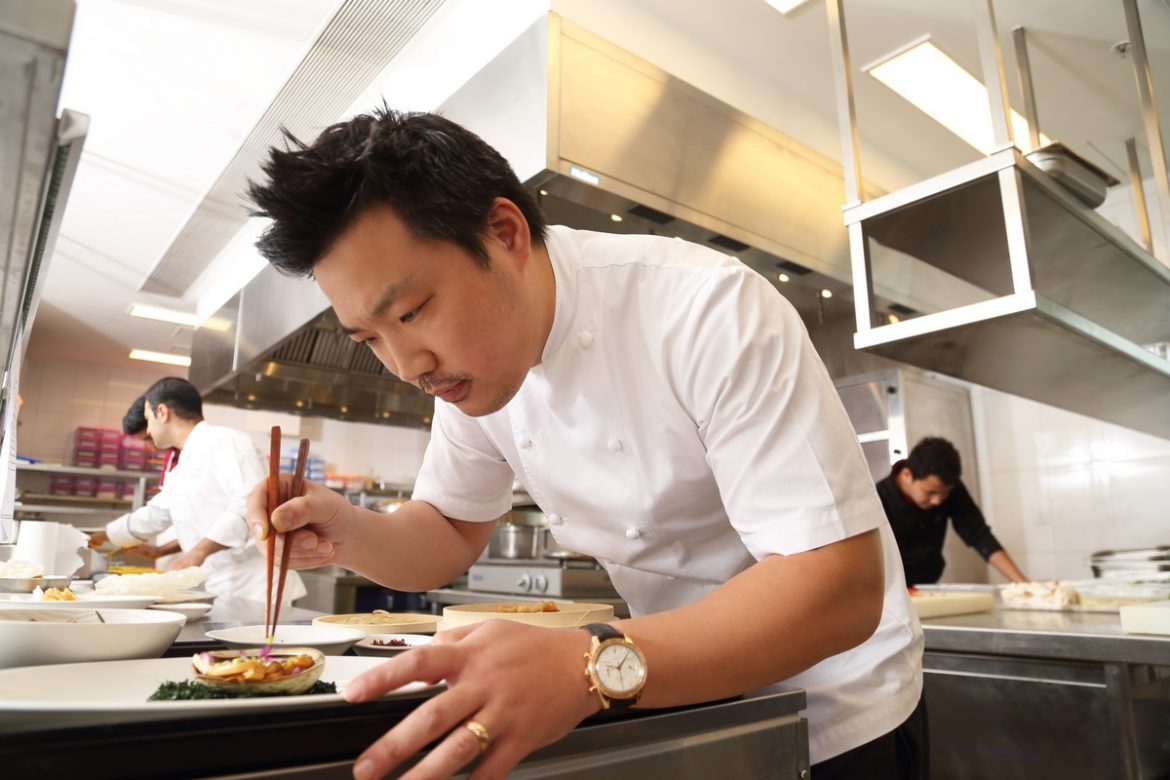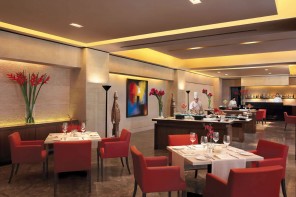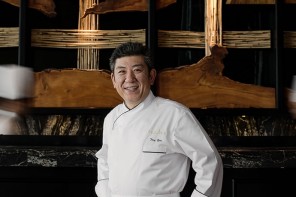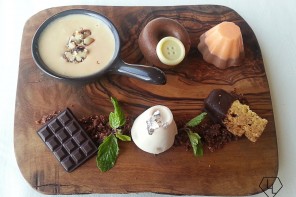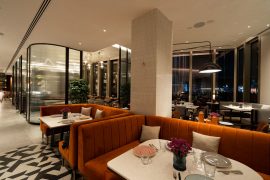It has all the quintessential elements that you usually find in a typical Chinese restaurant. The slatted ceiling reminiscent of a ribbed hand fan, the vases, embroidery and tassles that adorn some of the walls, the glass sconces shaped like stacked Chinese lanterns, dragon-like motifs manifesting themselves on chairs and a predominance of red and dark wood accents may all sound like the trite traditional treasures you’ve come to expect. And yet the stylish 70-seater Baoshuan, on the rooftop of The Oberoi, New Delhi, is somehow greater than the sum of its many parts. The overall feel is fresh and on point, even in the private dining for 10 that’s all burnished brass and glistening glass.
The timeless space is perhaps the perfect foil for the menu, which draws from China’s centuries old culinary roots even though it’s rooted firmly in the present. It’s an innovative take on traditional recipes that gives patrons what they want, and when possible, introduces the open-minded amongst them to ‘future favourites’. London lad Chef Andrew Wong is the man behind Baoshuan’s menu and a mentor to the talented team. As the driving force behind two of his own restaurants, one of which has won the coveted Michelin star for ostensibly ‘retaining the essence of a dish, whilst adding an impressive lightness and intensity of flavour’, he’s won multiple awards and been hailed as chef of the year. We talked to the dim sum dynamo about his culinary journey and what we can expect from him next. Here are excerpts from the interview…
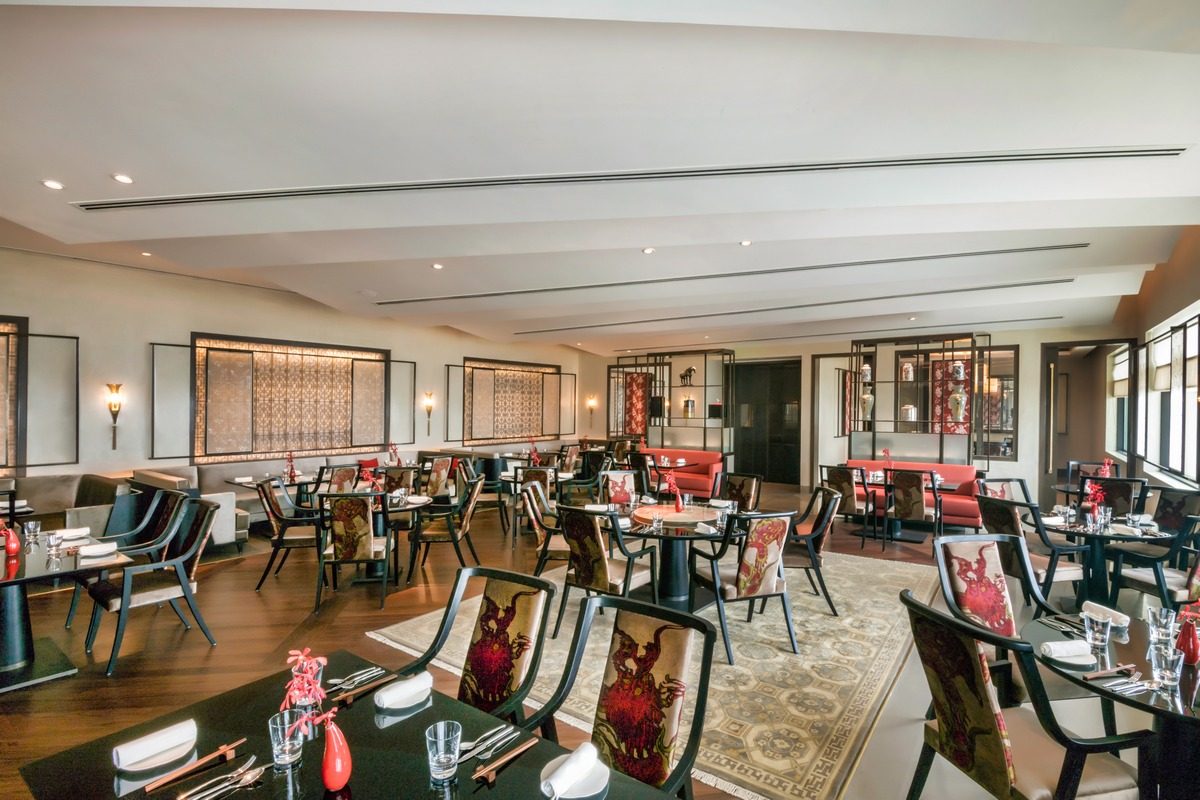
Luxurylaunches: Was it initially a culture shock for you when you travelled around China’s rich culinary landscape and studied the cuisine in the heartland of its origin? Do you recall an incident from that period that impacted your career as a chef?
Chef Andrew Wong: Growing up, we spent a lot of time in China so it wasn’t a sense of a large-scale culture shock. However, it was the first time in my life that I was living and seeing, first-hand, the sheer scale of diversity that existed between regions. Chefs, for example, would never refer to themselves as ‘Chinese chefs’ but would be regionally specific, calling themselves ‘Sichuanese chefs’ or ‘Cantonese chefs’.
LL: From Beijing Khao Ya to Cantonese dim sum, you seem to have explored many regions and dishes of China. Do you have a favourite cooking style or ingredient or philosophy that is at the root of all your culinary creations?
Chef AW: What is important for all our restaurants in London and in Delhi, is to show our guests the plethora of flavours that exist throughout China. I will always have a soft spot for Cantonese cooking though, especially Dim Sum, as it is such a specialised, artisanal craft that takes decades of practice to perfect. I dedicate many hours each day in repeatedly practicing my dim sum-making with the team to try to refine and improve all the time.
LL: It’s been seven years since you opened Restaurant A. WONG in London. How often do you change the menu there? How do you manage to balance the ratio of classic dishes to the more modern versions of them using trendier ingredients? Are you a purist when it comes to traditional recipes?
Chef AW: Evolving a menu is constant, this happens both in London and in Delhi. Ingredients are not always available, and we are always striving to improve dishes. It is very important to me that the heart of all our dishes remain true to China and her gastronomy. Modernity of cuisine is just a natural evolution of cuisine; it will ultimately be the tradition of the future.
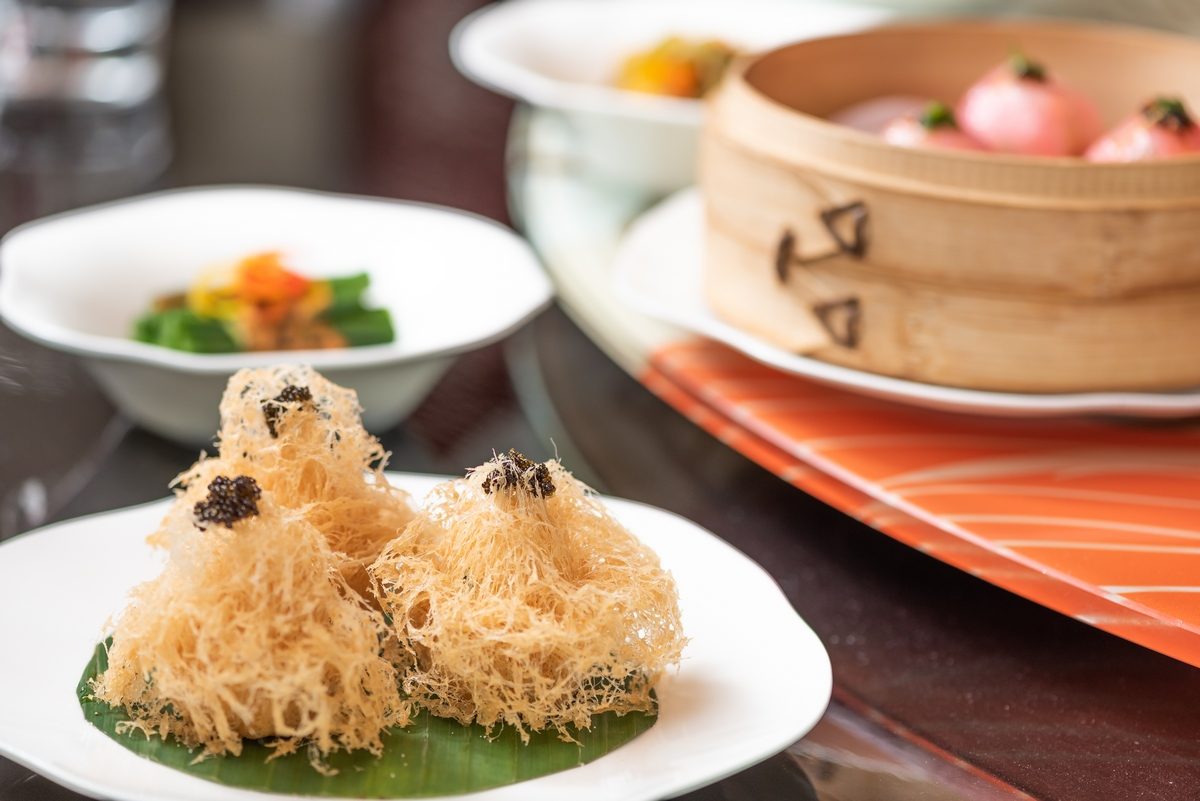


LL: How hard is it to retain a Michelin star? What, according to you, are the things you need to do to keep to that high standard?
Chef AW: Keeping standards high is a necessity. However, what is more important is that the restaurants constantly evolve and improve. Restaurants take years to develop their true inner character and when they blossom, it is so important to continue the growth, responding to guest feedback, yet keeping the team challenged and excited daily. I really look forward to the day that Michelin comes to India. India has all the ingredients for an amazing guide. I have been to Delhi six times now over the past 24 months, and each time, the diversity and quality of restaurants blow me away.
LL: When was the first time you visited India? Did you make a discovery about Indian cuisine and cooking techniques when you were here that you hadn’t imagined existed before you came?
Chef AW: I first visited India just over two years ago. What both India and China have in common is a very unique set of cooking techniques that is yet completely undiscovered by the global culinary scene. For example, marination techniques, unique use of charcoal and tandoors, the use of spices, the use of chillies. I am sure there are so many things that I could mention that locals would completely take for granted, but as a chef unfamiliar with Indian techniques, I find them fascinating! Say, for instance, making set curd, the grinding of lentils to make dosas, the incredible range of breads, each one with a specific end-goal of softness or crispness. Every time I visit, I learn so much from the team, both at Baoshuan and at The Oberoi, New Delhi.
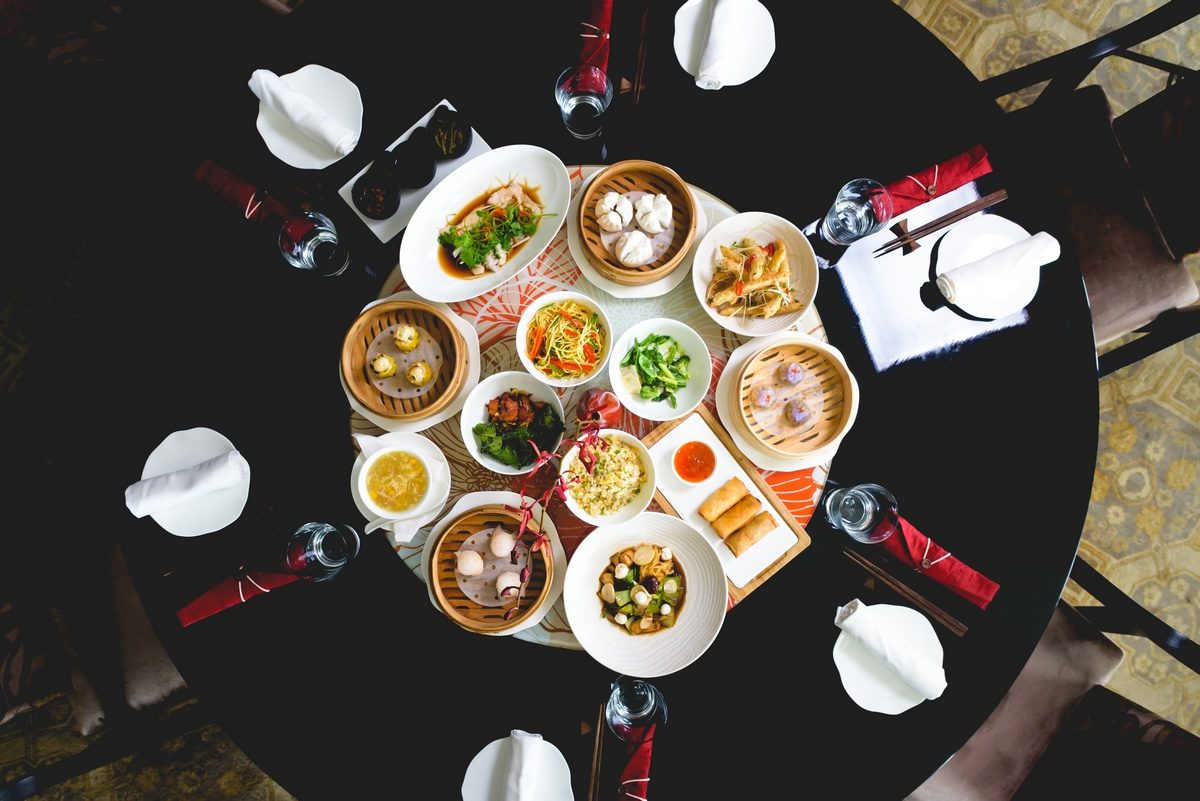


LL: How did it make you feel to know that Chinese food is so popular in this country?
Chef AW: Chinese food has travelled so well internationally. The very first Chinese restaurant in London in example is dated back to 1908. What really interests me is seeing how a local culture takes Chinese gastronomy and makes it their own, adding ingredients and evolving the cuisine to fit the local tastes and preferences. In India, the bond and relationship with Chinese food is very, very strong. Every day is a learning curve on finding the correct dishes from China that match people’s taste preferences.
LL: Have you tasted ‘Indianised Chinese’? What was your reaction to it?
Chef AW: I love it! It has nothing to do with China, but I love it! It’s umami rich and spicy, who wouldn’t like it???
LL: How did the mentorship at Baoshuan come about?
Chef AW: I have been in the industry for 17 years now. One of the most important things that I have learnt is that one must always try to surround themselves with people that they can learn from, people who share the same core values and sentiments. Before coming to India, I had no intention of ever opening more restaurants than A. WONG in London. However, interactions with the team at The Oberoi turned it all around for me; one couldn’t help but feel the magic that exists here. I was overwhelmed with the sense of ‘family’ that still exists within a company that is so large and global.
LL: Did you decide on the name? Does it hold any special meaning/significance to you?
Chef AW: I have been working with a Chinese food anthropologist now for five years. Dr Das has in-depth knowledge about ancient recipes and how they have travelled over our 3,000-year-old culinary history. A lot of our dish development starts off from information that is supplied by her. She was instrumental in coming up with the name of Baoshuan. The word ‘Baoshuan’ literally translates to ‘Chinese Treasure Ships’ and celebrates the earliest travels from China to the Middle East and India. Fleets of ships would carry the very best of what China had to offer including silk, spices and grain to India in exchange for the incredible ingredients from here.
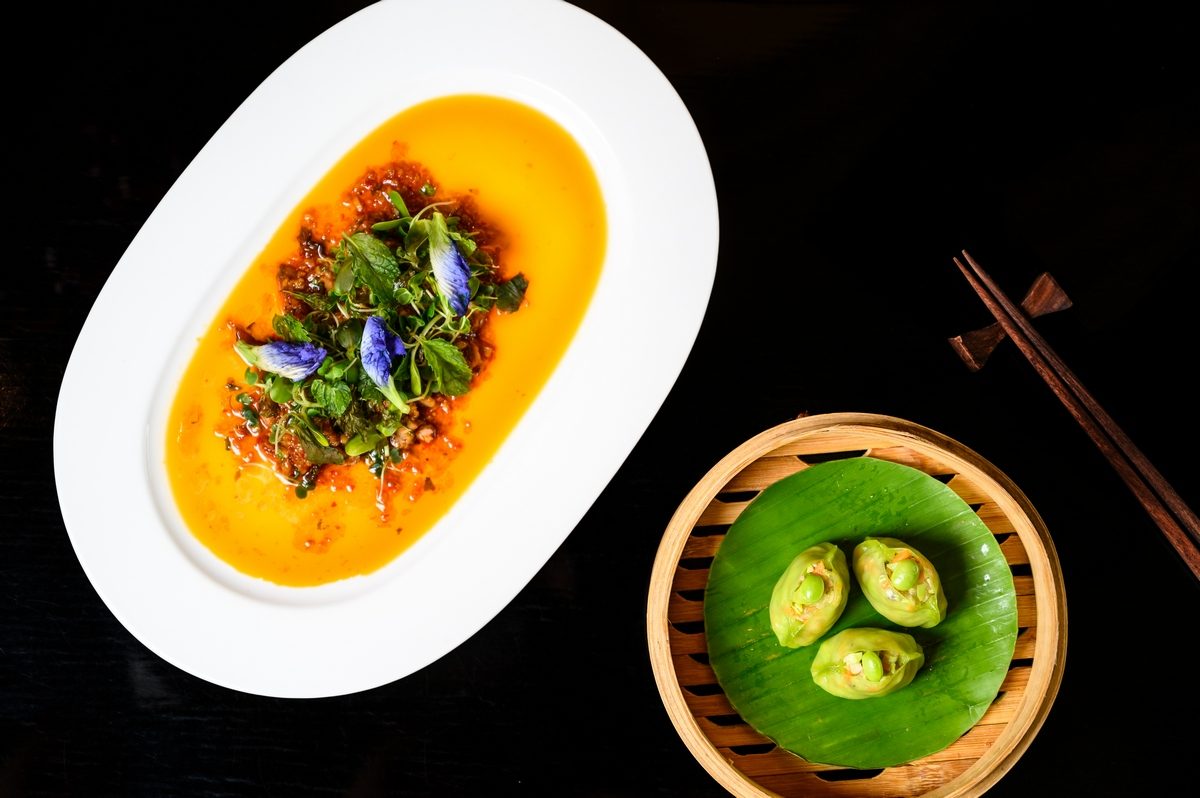


LL: How much time and research did you invest in creating the menu? How has the response over the months been and have you had to tweak anything over the past year?
Chef AW: Between myself and Chef de Cuisine ChuanXi Sun, who looks after the day-to-day running of the kitchen at Baoshuan, we must have a collection of over several thousand dishes in our notebooks, dishes from our past, dishes that we like, dishes that we would like to try. A menu can only have so many dishes so it is about making a collective decision of which dishes we think will work best. The menu at Baoshuan has constantly changed since the opening and will continue to evolve constantly. I have recently just returned from Baoshuan and on this visit, we concentrated on our exploration of dim sums and also fermented and pickled palate-cleansing dishes that traditionally are used to begin a meal. We are constantly trying to push the boundaries and possibilities of our dim sums at Baoshuan in order to keep our guests excited each time they visit. We now run an Infinity Brunch throughout the week, allowing guests to order an endless amount of handcrafted dim sums, appetisers and signature mains.
LL: How much did you need to adapt your recipes and the balance of flavours for the Delhi palate?
Chef AW: There are several inescapable truths about the Delhi palate, which are not universal, but pretty prevalent: the love for chicken, chilli and sauce is a very important part of what is perceived as familiar. Not all dishes in China will, of course, fit these criteria. Our menu at Baoshuan, now approaching two years of successful operations, now holds a nice balance between dishes that fit this brief, yet at the same time, also have dishes that don’t. This allows for a wide range of options and choices for guests to try! A Chinese meal whether it be at A. WONG and Kyms in London or in Baoshuan in Delhi, is all about ordering an array of dishes that bring in contrasts in textures, temperature, spice levels, sauciness and crispness. When one experiences this, they are getting a true experience of what Chinese food is about.
LL: What modifications would you make to your menu in future in order to introduce well-heeled and well-travelled Indian diners to an even wider array of regional Chinese specialties? What are they ready for and what are they not yet ready to experience, in your opinion?
Chef AW: Menus as mentioned above are about creating a selection that allows for variety. A variety that allows our guests to see the diversity of China’s 14 international borders and its 3,000-year-old gastronomic past.
LL: Tell us your vision for the new Kym’s restaurant at London’s Bloomberg Arcade and what else you have up your sleeve…
Chef AW: Kyms started off when Dr Das, the food anthropologist that we work with, sent me a photo. It was a photo of an etching inscribed onto a wall of a cave. Dating back to over 2,500 years ago, the picture very clearly showing a chef carrying out the process of ‘Chinese roasting’. A process which remains pretty much unchanged today. This fascinated me – the timelessness of this technique. This became the core of the concept for Kyms, a celebration of the ancient art of Chinese roasting. What else do we have coming up? Restaurants take a long time to develop their unique character and, as a chef, the most exciting thing is watching them grow each day, watching guests grow with them in creating a warm, loving and unique restaurant that they enjoy themselves in.
Where: Baoshuan at The Oberoi, New Delhi
Dr Zakir Hussain Marg, Delhi Golf Club,
Golf Links, New Delhi, Delhi 110003
Phone: 011 2436 3030

